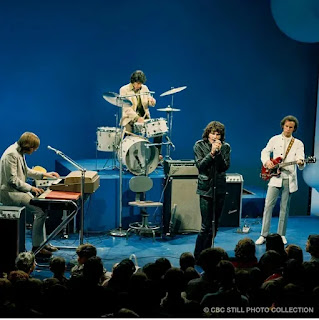THE DOORS' "RIDERS ON THE STORM": A TRIP THROUGH RAY MANZAREK'S SOLO
"Riders On The Storm" is undoubtedly one of The
Doors' most iconic songs: a canvas painted with hypnotic and somber sounds, as
well as the last track the band taped in the studio before Jim Morrison's
death.
Recorded in late 1970 and early 1971, the composition
runs for more than seven minutes and would serve as a fascinating closing track
on the group's last LP as a quartet: "L.A. Woman" (released in April
'71).
One of the most striking passages on this track is keyboardist
Ray Manzarek's solo.
Lasting about two minutes, this significant
instrumental excursion stretches as much as the one the musician played on
"Light My Fire" more than four years earlier (here is the link
to the article where I discuss Manzarek's solo on "Light My Fire").
While in "Light My Fire" Manzarek uses the
electric organ (a Vox Continental), in "Riders On The Storm" we can
enjoy the vibrations of another keyboard: the electric piano (a Fender Rhodes Piano).
By the early 1970s, this evolution of the classical
piano had been employed in various musical contexts for at least twenty years,
although its widespread adoption was still relatively recent.
Launched in the context of the first wave of
electrified instruments (late 1930s), it was brought to the attention of a wide
audience by the song "What I'd Say" by Ray Charles (1959) and ultimately
integrated into mass music by The Beatles (from "The Night Before" in
1965 to "Get Back" in 1970).
The sound of the electric piano smooths the sharp
edges characteristic of the traditional piano, making its sound mellower and more resonant.
Thanks to its soft metallic timbre, at once rounded, intense
and capable of lingering for a long time, the electric
piano produces richer and more persistent nuances than the acoustic piano.
Manzarek takes advantage of this keyboard's potential
by conceiving a solo with a distinct jazz profile, vividly reminiscent of Hard Bop
and Jazz Soul styles.
This solo journey begins at min. 2.43 of the
composition and ends at min. 4.30 (occupying just under a third of the total
tune’s length) and is divided into three clearly distinguishable parts.
The first section (from min. 2.43 to min. 3.18) adopts
a nuanced and soft approach in which melodic elements emerge tenuous and
interesting at the same time.
They are lightly hinted at and follow each other effectively, emphasizing the suspended silences as integral elements of the
phrasing itself.
This first section ends with a delightful figure (at
min. 3.14) whose sweet expressiveness has a vague, mysterious quality.
The second part of the solo (min. 3.19 to min. 4.23)
moves in a dynamic and decisive atmosphere, giving the
darkly magnetic feeling of the song a temporary twist.
Here, the pattern that Manzarek builds up echoes the
rhythmic-melodic emphasis typical of Jazz Soul, pushing forward vividly marked
accents, while drawing ingeniously enthralling and engaging phrases.
This is also achieved thanks to the transition from
single notes to chords, which the keyboardist makes starting at min. 3.38,
further thickening and strengthening the sound of the electric piano to the
point of giving the solo itself an almost percussive aspect.
The third and final section of this journey into
Manzarek's solo part is also the shortest (min. 4.24 to min. 4.30).
Here the enigmatic and dreamy descending line heard at
the beginning of the song (at min. 0.29) is repeated. A perfect ending for the
solo, it flows with an ethereal pace across the keyboard, gradually descending
to lower notes like an awakening from a dream drenched in extravagant and
unreal colors.
Apart from the extraordinary solo just described, the
rhythmic accompaniment provided by the electric piano during the rest of the song
is also characterized by similar Jazz stylistic features.
Approaching the "comping" technique typical
of Hard Bop piano, the keyboardist introduces a jazz flavor into its role
as a rhythm instrument.
Throughout the song, the electric piano builds up in the background. Its oscillating chords are gently
undulated by the "vibrato" function of the Fender Rhodes piano, which is similar to the distortion effect commonly known as "tremolo".
This is also the case with the chords that follow the end of the solo like funeral bells at dusk (min. 4:30 to min. 4:39), and
lead to the reprise of the next verse.
With his elegant solo in "Riders On The
Storm," Manzarek writes a sonic epitaph to The Doors' history, an epitaph
made up of memorable notes coated in sinuous elegance and resonating with groovy
sadness.
My book "The Doors Through Strange Days"- The most comprehensive journey ever made through The Doors' second LP, is available on Amazon.com, uk, mx, ca, etc.
Here’s the link:




Comments
Post a Comment